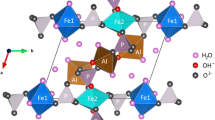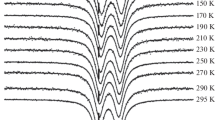Abstract
A sample of ferripyrophyllite, a mineral with ideal composition Fe2SiO10(OH)2, was analyzed by Mössbauer spectroscopy, magnetization and magnetic susceptibility measurements. The iron is entirely ferric, and the main feature of the Mössbauer spectrum at room temperature is a single absorption line with isomer shift δ = 0.36(1) mm/sec due to iron in M2 sites. The line is broadened by a slight quadrupole splitting Δ = 0.18(1) mm/sec, the smallest yet reported for a sheet silicate. Weaker features corresponding to quadrupole doublets with relative intensities of 7% and 8% having δ = 0.43(1) mm/sec; Δ = 1.22(2) mm/sec and δ = 0.14(1) mm/sec; Δ = 0.59(2) mm/sec are assigned to ferric iron in nonequivalent octahedral and tetrahedral sites, respectively, giving the following formula, based on published chemical analysis: Ca0.05(Fe3+1.87Mg0.11Al0.09)VI(Si3.80Fe3+0.16Al0.04)IVO10(OH)2, where Ca is in interlayer sites. Ferripyrophyllite orders antiferromagnetically at 18(2)°K. The Mössbauer spectrum at 4.2°K consists of a single, resolved magnetic pattern with hyperfine field Bhf = 51.8 T. The relatively high Néel temperature compared with other dioctahedral ferric phyllosilicates provides further evidence that Fe3+ cations tend to be ordered on M2 sites within the octahedral sheet.
Резюме
Образец феррипирофиллита, минерала с идеальной формулой (Fe2)(Si4)O10(OH)2, исследован с помощью Мессбауэровской спектроскопии, измерений намагничивания и магнитной восприимчивости. Все железо полностью является окисным, и главной чертой Мессбауэровских спектров при комнатной температуре является одиночная линия поглощения с изомерным сдвигом δ = 0,36(1) мм/с, относящаяся к железу в позиции М2. Линия расширена слабым квадрупольным расщеплением Δ = 0,18(1) мм/с, наименьшим из до сих пор известных для слоистых силикатов. Более слабые особенности, выражаемые квадрупольными дублетами с относительными интенсивностями в 7 и 8%, имеющие δ = 0,43(1) мм/с, Δ = 1,22(2) мм/с; и δ = 0,14(1) мм/с, Δ = 0,59(2) мм/с отнесены к окисному железу в неэквивалентных октаэдрических и тетраэдрических позициях соответственно, что на основании опубликованных данных химического анализа дает следующую формулу Ca0,05(Fe3+1.87Mg0.11Al0.09)VI(Si3,80Fe3+0.16Al0.04)IVO10(OH)2. Феррипирофиллит характеризуется антиферромагнитным упорядочением при 18(2)°К. Мессбауэровский спектр при 4,2°К состоит из одиночного секстета с разрешением сверхтонкой картины магнитного поля Bhf = 51,8°Т. Сравнительно высокая температура Нееля (в отличие от таковой у других филосиликатов окисного железа) служит дополнительным свидетельством тенденции к упорядоченному распределению катионов Fe3+ по ок-таэдрическим позициям М2.
Resümee
Eine Probe von Ferripyrophyllit, einem Mineral mit der idealen Zusammensetzung Fe2Si4O10(OH)2, wurde mittels Mössbauer-Spektroskopie, Magnetisierungs- und magnetischen Suszep-tibilitäts-Messungen untersucht. Das Eisen ist ausschließlich Fe3+, und das Hauptcharakteristikum des Mössbauer-Spektrums bei Raumtemperatur ist eine einzige Absorptionslinie mit einer Isomerverschiebung δ = 0,36(1) mm/sec, die durch Eisen auf M2-Plätzen hervorgerufen wird. Die Linie wird durch eine leichte Quadrupol-Aufspaltung von Δ = 0,18(1) mm/sec verbreitet, die kleinste, die je für ein Schichtsilikat angegeben wurde. Schwächere Charakteristika, die Quadrupol-Dubletten mit relativen Intensitäten von 7% und 8% entsprechen, und die Werte von δ = 0,43(1) mm/sec, Δ = 1,22(2) mm/sec und δ = 0,14(1) mm/sec; Δ = 0,59(2) mm/sec haben, deuten auf Fe3+ auf nichtäquivalenten oktaedrischen bzw. tetrae-drischen Plätzen hin, woraus sich die folgende, auf publizierten chemischen Daten basierende Formel ergibt: Ca0,05(Fe3+1,87Mg0,11Al0,09)VI(Si3,80Fe3+0,16Al0,04)IVO10(OH)2, wobei das Ca auf Zwischenschichtpiätzen sitzt.
Ferripyrophyllit zeigt bei 18(2)°K antiferromagnetische Ordnung. Das Mössbauer-Spektrum bei 4,2°K besteht aus einem einzigen aufgelösten magnetischen Signal mit einem Hyperfeinfeld Bhf = 51,8 T. Die im Vergleich mit anderen dioktaedrischen Ferri-Phyllosilikaten relativ hohe Néel Temperatur liefert einen weiteren Beweis, dairs Fe3+-Kationen dazu neigen, auf den M2-Plätzen innerhalb der Oktaederschicht angeordnet zu sein. [U.W.]
Résumé
Un échantillon de ferripyrophyllite, un minéral dont la composition idéale est Fe2Si4O10(OH)2, a été analysé par spectroscopic Mössbauer, et par mesures d’aimantation et de susceptibilité magnétique. La fer est entièrement ferrique, et à température ambiante, la caractéristique principale du spectre Mössbauer est une seule raie d’absorption avec déplacement isomerique δ = 0,36(1) mm/sec à cause de la présence de fer dans les sites M2. La raie est élargie par une légère dedoublement quadropolaire Δ = 0,18(1) mm/sec, jusqu’à présent, la plus petite rapportée pour une silicate à feuilles. Des caractéristiques plus faibles correspondant à des doublets quadropolaires ayant des intensités relatives de 7% et de 8%, et ayant δ = 0,43(1) mm/sec; Δ = 1,22(2) mm/sec et δ = 0,14(1) mm/sec; Δ = 0,59(2) mm/sec sont assignées au fer ferrique dans les sites octaédraux et tetraédraux nonéquivalents, respectivement, donnant la formule suivante, basée sur une analyse chimique publiée: Ca0,05(Fe3+1,87Mg0,11Al0,09)VI(Si3,80Fe3+0,16Al0,04)IVO10(OH)2, où Ca est dans des sites intercouches.
La ferripyrophyllite s’ordonne antiferromagnétiquement à 18(2)°K. Le spectre Mössbauer à 4.2°K consiste en un seul cliché magnétique résolu avec un champ hyperfin Bhf = 51,8 T. La température de Néel relativement élevée comparée à d’autres phyllosilicates ferriques octaédriques fournit d’avantage d’évidence que les cations Fe3+ ont tendance à s’ordonner sur les sites M2 au sein du feuillet octaédrique. [D.J.]
Similar content being viewed by others
References
Annersten, H., Devanarayanan, S., Häggström, L., and Wäppling, R. (1971) Mössbauer study of synthetic ferriphlogo-pite: Phys. Stat. Sol. 64b, K137–138.
Ballet, O. and Coey, J. M. D. (1982) Magnetic properties of sheet silicates; 2:1 layer minerals: Phys. Chem. Minerals 8, 218–229.
Besson, G., Bookin, S., Dainyak, L. G., Rautureau, M., Tsi-purski, S. I., Tchoubar, C., and Drits, V. A. (1983) Use of diffraction and Mössbauer methods for the structural and crystallochemical characterization of nontronites: J. Appl. Ctyst. 16, 374–380.
Bonnin, D. (1981) Propriétés magnétiques liées aux désordres bidimensionnels dans un silicate lamellaire ferique: la nontronite: Thèse d'Etat, Paris, 82 pp.
Bookin, A. S., Dainyak, L. G., and Drits, V. A. (1978) Interpretation of the Mössbauer spectra of layer silicates on the basis of structural modelling: Phys. Chem. Minerals 3, 58–59.
Chukhrov, F. V., Zvyagin, V. V., Drits, V. A., Gorshkov, A. I., Ermilova, L. P., Goilo, E. A., and Rudnitskaya, E. S. (1979a). The ferric analogue of pyrophyllite and related phases: in Proc. Int. Clay Conference, Oxford, 1978, M. M. Mortland and V. S. Farmer, eds., Elsevier, Amsterdam, 55–64.
Chukhrov, F. V., Zvyagin, V. V., Drits, V. A., Gorshkov, A. I., Ermilova, L. P., Goilo, E. A., and Rudnitskaya, E. S. (1979b) Über ferripyrophyllit: Chem. Erde 38, 324–330.
Coey, J. M. D. (1980) Clay minerals and their transformations studied with nuclear techniques: the contribution of Mössbauer spectroscopy: Atomic Energy Review 18, 73–124.
Coey, J. M. D., Moukarika, A., and Ballet, O. (1982) Magnetic order in silicate minerals: J. Appl. Phys. 53, 8320–8325.
Coey, J. M. D. and Murphy, P. J. K. (1982) An octahedral random network: J. Noncryst. Solids 50, 125–129.
Coey, J. M. D. (1984) Silicate minerals: in Mössbauer Spectroscopy Applied to Inorganic Chemistry, G. J. Long, ed., Plenum Press, New York (in press).
Dainyak, L. G. (1980) Interpretation of ngr spectra of some Fe3+-bearing layer silicates on the basis of structural modelling: Candidates Thesis, Kazan State University, 125 pp. (in Russian).
Ferey, G., Varret, F., and Coey, J. M. D. (1979) Amorphous FeF3: a non-crystalline magnet with antiferromagnetic interactions: J. Phys. S. 12, L531–L537.
Goodman, B. A., Russell, J. D., Fraser, A. R., and Woodhams, F. W. D. (1976) A Mössbauer and i.r. spectroscopic study of the structure of nontronite: Clays & Clay Minerals 24, 53–59.
Goodman, B. A. (1978) The Mössbauer spectra of non-tronites: consideration of an alternative assignment: Clays & Clay Minerals 26, 176–177.
Goodman, B. A. (1980) Mössbauer spectroscopy: in Advanced Chemical Methods for Soil and Clay Minerals Research, J. W. Stucki and N. W. L. Banwart, eds., Reidel, Dordrecht, The Netherlands, 1–92.
Govaert, A., de Grave, E., Quartier, H., Chambraere, D., and Robbrecht, G. (1979) Mössbauer analysis of glauconites from different Belgian localities: J. Physique 40, 442–444.
Heller-Kallai, L. and Rozenson, I. (1981) The use of Mössbauer spectroscopy of iron in clay mineralogy: Phys. Chem. Minerals 7, 223–238.
Kotlicki, A., Szczyrba, J., and Wiewiora, A. (1981) Mössbauer study of glauconites from Poland: Clay Miner. 16, 221–230.
Rozenson, I. and Heller-Kallai, L. (1978) Mössbauer spectra of glauconites reexamined: Clays & Clay Minerals 26, 173–175.
Smart, J. S. (1966) Effective Field Theories of Magnetism: Saunders, Philadelphia, p. 58.
Author information
Authors and Affiliations
Rights and permissions
About this article
Cite this article
Coey, J.M.D., Chukhrov, F.V. & Zvyagin, B.B. Cation Distribution, Mössbauer Spectra, and Magnetic Properties of Ferripyrophyllite. Clays Clay Miner. 32, 198–204 (1984). https://doi.org/10.1346/CCMN.1984.0320307
Received:
Accepted:
Published:
Issue Date:
DOI: https://doi.org/10.1346/CCMN.1984.0320307




